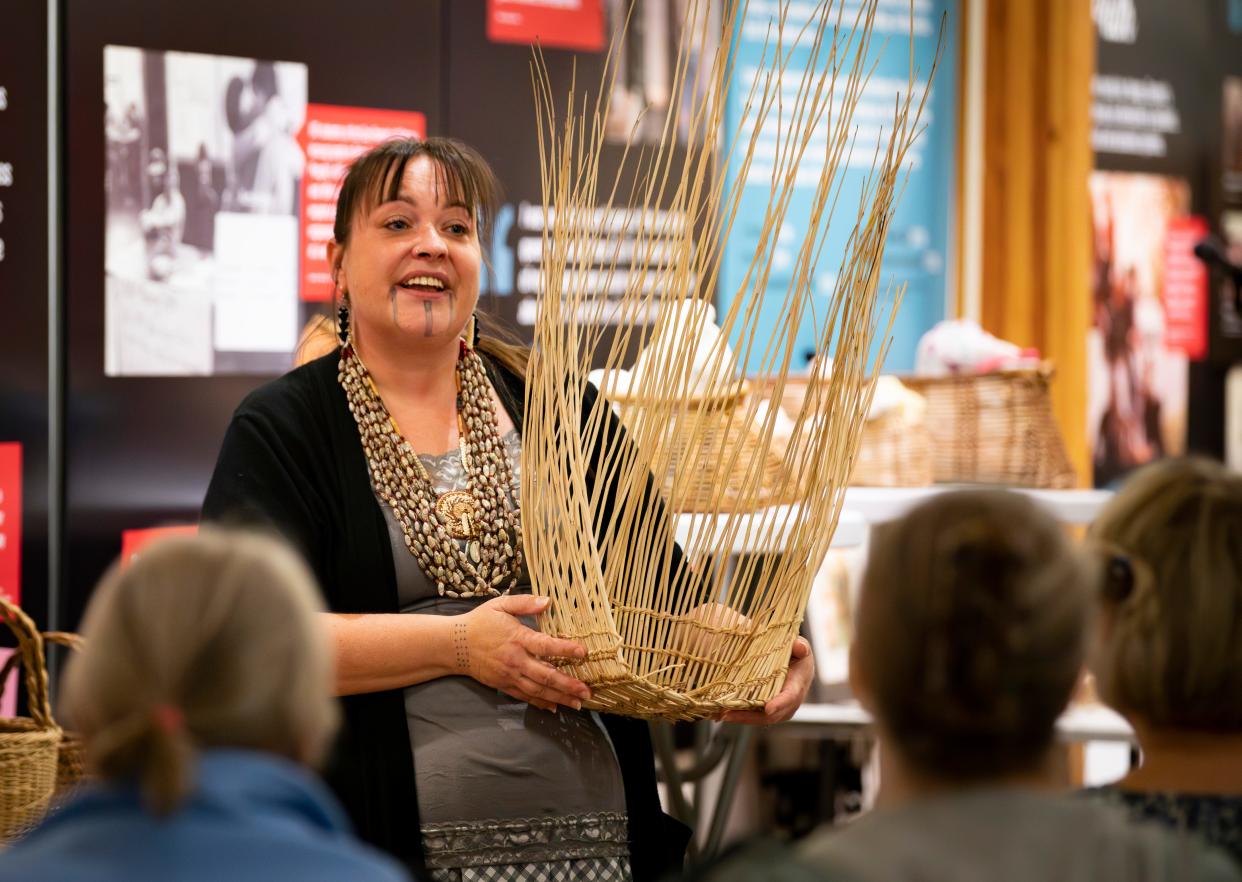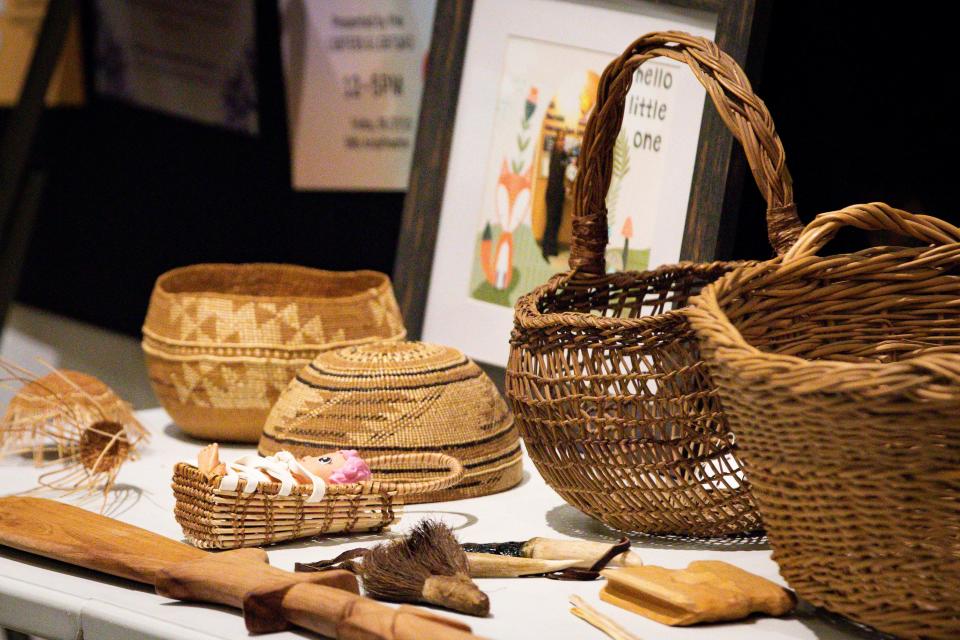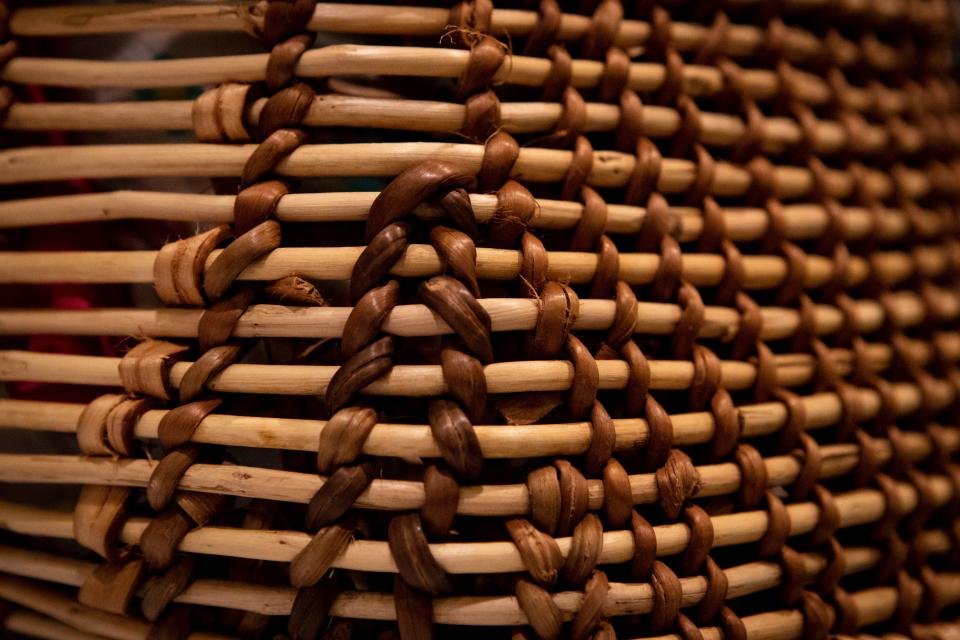'My ancestors chose me': Stephanie Craig embraces tradition through basket weaving

For 25 years, Stephanie Craig has been practicing traditional Indigenous basket weaving, fighting carpal tunnel and arthritis in her hands, in order to keep the tradition alive.
Craig, a member of the Confederated Tribes of Grand Ronde, is of Santiam and Yoncalla Kalapuya, Takelma Rogue River, Cow Creek Umpqua and Clackamas Chinook descent. She's made it her life's work to preserve her ancestors' traditions through the practice of basket weaving.
"No one in our Tribe at the time was working with natural materials," Craig said. "I come from a very well-known basketry family, and there was no one in our family that was doing anything traditional.
"For whatever reason, my ancestors chose me as the person to do it and it just has been super easy to do."
Craig has been teaching classes and giving presentations at the University of Oregon's Museum of Natural and Cultural History for 20 years, sharing her journey to becoming the weaver she is today. She brought some of her own work and showcased some items from the MNCH's collection on a visit earlier this month. The exhibit area was nearly overflowing, with more than 50 people listening to Craig.
When she was younger, much of her identity was suppressed. Craig wasn't raised with many of the traditions she now practices, and her mother wasn't raised with them either. Her mother, who grew up on the reservation, attended public school and was told to not tell anyone she was Native or she would be ridiculed.
Craig's parents told her to hide her identity as well to protect her from being bullied. It wasn't until she was in college at the University of Oregon that Craig said she felt safe to identify as Native American in public spaces.
She spent about 10 years at UO, earning her bachelor's degree in cultural anthropology, and then her master's degree in cultural anthropology, museum studies and folklore. Craig also was the first Grand Ronde Tribal member to graduate using Chinuk Wawa, her Native language, for her foreign language requirement at UO.
Now, Craig has made weaving her life's work.
Returning baskets, heirlooms to their original homes: 'We are the best keepers'
Craig grew up in Dayton where her family has a 100-acre farm. She and her family still live there. Now her children help her gather basket materials on their land.
This traditional type of basket weaving is done using natural materials, commonly hazel sticks and spruce roots. But Craig has used other materials such as cedar, maple, sedges and rushes for the countless baskets she's made.
While basket weaving is a common practice among Indigenous cultures, the materials used and weaving techniques employed often vary significantly.

While at UO, Craig also became an intern at the museum, where she saw Indigenous heirlooms, many of which were incorrectly labeled.
During her first visit, a docent was explaining the history behind a picture on the wall, but the photo was of Craig's own family. She ended up telling the docent more details including the name of the dog in the photo and how everyone was related to one another.
"By the time I got done talking, I had almost all the museum staff out of the back and standing there listening to me," Craig said. "I was asked and offered if I wanted to be on a docent list, but I didn't need the training."
Craig was able to provide context and identify many items at MNCH, later interning at the Smithsonian doing similar work, and interning for the Confederated Tribes of the Umatilla Indian Reservation's Tamastslikt Cultural Institute. Since she began weaving and studying more traditional weaving throughout Indigenous cultures, she is able to easily identify baskets not only from her own heritage but those from across the Pacific Northwest.
Craig has identified thousands of baskets and other heirlooms, some she can even trace to a specific family or individual. She said she gets emails regularly and identifies baskets almost daily.
Her business, Kalapuya Weaving & Consulting, does basket weaving classes, and museum and agency consulting for federal, state, city or Tribal institutions, private collectors, and gallery owners. She also helps with exhibit designs and interpretation.
"(It's) anything from identifying items to putting them on display to teaching basketry classes or cultural competency classes," Craig said. "I do a lot of working with archaeologists ... so that way that when they do find stuff they don't misidentify it."
Craig said this work has been fulfilling to her, describing it as "solving a mystery."
Her end goal, however, is to get as many items returned to their rightful homes as possible. She said it's ultimately up to the person who currently owns the items, but if she's been able to identify down to the family, she stresses the importance of returning the belongings.
"Their family is hurting, and they probably don't know what's missing," she said. "Why leave it on a shelf or in storage at a museum, it's never going to be touched. It's never going to be used again. We Tribes, we know how to take care of our own stuff. We are the best keepers."
Carrying on traditional Indigenous basket weaving traditions
Above all else, Craig said she weaves for her ancestors, her Tribe and her two children, William and Josie.
"If I'm not doing it, who's gonna do it?" Craig said. "I'm constantly, constantly weaving."
Craig has worked with apprentices in the past, but mastering the skill is "hard, hard work." Her apprentice Dakota Zimmer, of the Confederated Tribes of Grand Ronde and a student at Oregon State University, recently had to completely redo a basket she's been working on four times. Craig estimates that she's put more than 20 hours of work into it so far.

Despite the intricate practice, weaving came easily to Craig.
"It just comes to me in dreams," Craig said. "My fingers dance with the material. I don't have to look on my hands. I feel like my ancestors are guiding me. My grandmothers are guiding me. It makes me feel good that I'm continuing this work and hopefully inspiring others to to start picking it up."
But Craig knows that her weaving time will likely come to an end at some point soon. She has had three carpal tunnel surgeries and has arthritis in her hands. One of the reasons she prefers working with rushes and hedges is because they are easier on her hands to weave.
She was told 14 years ago that she would have about 12 years of weaving left.
"I probably have just a couple years left," Craig said. "I struggle today when I teach and when I'm weaving... My hands are giving out, so I've got a lot to do before that happens."
In addition to passing her knowledge within her Tribe, Craig said she loves being able to share her experience with non-Natives as well. It's important for non-Natives to allow for that space. She said sharing and educating is an opportunity to say "we are still here."
Craig said she intends to teach her daughter the traditions of basket weaving. She wants Josie to be able to identify baskets as she does.
At just 2-and-a-half, Josie is already enthusiastic about her mom's work, eager to help and curious. Josie is particularly intrigued by the prospect of having a traditional 111 tattoo on her chin. High-ranking Takelma girls receive the tattoo during a coming of age ceremony. The lines are thickened when they are married. Craig got her 111 tattoo a few years ago during her own ceremony. She received permission from the eldest man and woman from her tribe at the time.
"Whenever she sees my stuff out, 'Mom, are you weaving?" Craig said. "She asks every day for us to put her 111 tattoo on her chin... so she gets it drawn on every day."
Traditionally, basket weaving was done by women or two-spirit people, who would be considered transgender in modern terms. Because keeping these traditions alive is so vital, Craig said she will only be teaching her daughter and other Tribal members traditional woven items. But she teaches basketry to anyone. Her son, who turns 5 in December, also has responsibilities in her husband's family and Tribe, Umatilla.
Craig said she and her husband embrace a traditional lifestyle in many ways, not just with basket weaving, so their children will grow up not knowing any different. They practice spirituality, eat traditional foods and speak their languages every day.
"I am very lucky and humbled to have the opportunities that I've had," Craig said. "I've had a lot of people, good people, believe in me... but also, I have children now, and so making sure that they don't go without."
Contact reporter Miranda Cyr at mcyr@registerguard.com or find her on Twitter @mirandabcyr
This article originally appeared on Register-Guard: Stephanie Craig embraces traditionally basket weaving

